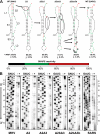Achieving a golden mean: mechanisms by which coronaviruses ensure synthesis of the correct stoichiometric ratios of viral proteins
- PMID: 20164235
- PMCID: PMC2863758
- DOI: 10.1128/JVI.02480-09
Achieving a golden mean: mechanisms by which coronaviruses ensure synthesis of the correct stoichiometric ratios of viral proteins
Abstract
In retroviruses and the double-stranded RNA totiviruses, the efficiency of programmed -1 ribosomal frameshifting is critical for ensuring the proper ratios of upstream-encoded capsid proteins to downstream-encoded replicase enzymes. The genomic organizations of many other frameshifting viruses, including the coronaviruses, are very different, in that their upstream open reading frames encode nonstructural proteins, the frameshift-dependent downstream open reading frames encode enzymes involved in transcription and replication, and their structural proteins are encoded by subgenomic mRNAs. The biological significance of frameshifting efficiency and how the relative ratios of proteins encoded by the upstream and downstream open reading frames affect virus propagation has not been explored before. Here, three different strategies were employed to test the hypothesis that the -1 PRF signals of coronaviruses have evolved to produce the correct ratios of upstream- to downstream-encoded proteins. Specifically, infectious clones of the severe acute respiratory syndrome (SARS)-associated coronavirus harboring mutations that lower frameshift efficiency decreased infectivity by >4 orders of magnitude. Second, a series of frameshift-promoting mRNA pseudoknot mutants was employed to demonstrate that the frameshift signals of the SARS-associated coronavirus and mouse hepatitis virus have evolved to promote optimal frameshift efficiencies. Finally, we show that a previously described frameshift attenuator element does not actually affect frameshifting per se but rather serves to limit the fraction of ribosomes available for frameshifting. The findings of these analyses all support a "golden mean" model in which viruses use both programmed ribosomal frameshifting and translational attenuation to control the relative ratios of their encoded proteins.
Figures





Similar articles
-
Altering SARS coronavirus frameshift efficiency affects genomic and subgenomic RNA production.Viruses. 2013 Jan 18;5(1):279-94. doi: 10.3390/v5010279. Viruses. 2013. PMID: 23334702 Free PMC article.
-
A three-stemmed mRNA pseudoknot in the SARS coronavirus frameshift signal.PLoS Biol. 2005 Jun;3(6):e172. doi: 10.1371/journal.pbio.0030172. Epub 2005 May 17. PLoS Biol. 2005. PMID: 15884978 Free PMC article.
-
Programmed ribosomal frameshifting in HIV-1 and the SARS-CoV.Virus Res. 2006 Jul;119(1):29-42. doi: 10.1016/j.virusres.2005.10.008. Epub 2005 Nov 28. Virus Res. 2006. PMID: 16310880 Free PMC article. Review.
-
The role of programmed-1 ribosomal frameshifting in coronavirus propagation.Front Biosci. 2008 May 1;13:4873-81. doi: 10.2741/3046. Front Biosci. 2008. PMID: 18508552 Free PMC article. Review.
-
An atypical RNA pseudoknot stimulator and an upstream attenuation signal for -1 ribosomal frameshifting of SARS coronavirus.Nucleic Acids Res. 2005 Jul 29;33(13):4265-75. doi: 10.1093/nar/gki731. Print 2005. Nucleic Acids Res. 2005. PMID: 16055920 Free PMC article.
Cited by
-
Structural and functional conservation of the programmed -1 ribosomal frameshift signal of SARS-CoV-2.bioRxiv [Preprint]. 2020 Jun 15:2020.03.13.991083. doi: 10.1101/2020.03.13.991083. bioRxiv. 2020. Update in: J Biol Chem. 2020 Jul 31;295(31):10741-10748. doi: 10.1074/jbc.AC120.013449. PMID: 32587971 Free PMC article. Updated. Preprint.
-
Multiple Cis-acting elements modulate programmed -1 ribosomal frameshifting in Pea enation mosaic virus.Nucleic Acids Res. 2016 Jan 29;44(2):878-95. doi: 10.1093/nar/gkv1241. Epub 2015 Nov 17. Nucleic Acids Res. 2016. PMID: 26578603 Free PMC article.
-
A general strategy to inhibiting viral -1 frameshifting based on upstream attenuation duplex formation.Nucleic Acids Res. 2016 Jan 8;44(1):256-66. doi: 10.1093/nar/gkv1307. Epub 2015 Nov 26. Nucleic Acids Res. 2016. PMID: 26612863 Free PMC article.
-
Cyclic peptides targeting the SARS-CoV-2 programmed ribosomal frameshifting RNA from a multiplexed phage display library.Chem Sci. 2024 Oct 17;15(46):19520-19533. doi: 10.1039/d4sc04026k. eCollection 2024 Nov 27. Chem Sci. 2024. PMID: 39568906 Free PMC article.
-
A Cascade of Conformational Switches in SARS-CoV-2 Frameshifting: Coregulation by Upstream and Downstream Elements.Biochemistry. 2025 Feb 18;64(4):953-966. doi: 10.1021/acs.biochem.4c00641. Epub 2025 Feb 5. Biochemistry. 2025. PMID: 39907285 Free PMC article.
References
-
- Almazán, F., M. L. DeDiego, C. Galan, D. Escors, E. Alvarez, J. Ortego, I. Sola, S. Zuniga, S. Alonso, J. L. Moreno, A. Nogales, C. Capiscol, and L. Enjuanes. 2006. Construction of a severe acute respiratory syndrome coronavirus infectious cDNA clone and a replicon to study coronavirus RNA synthesis. J. Virol. 80:10900-10906. - PMC - PubMed
Publication types
MeSH terms
Substances
Grants and funding
LinkOut - more resources
Full Text Sources
Miscellaneous

